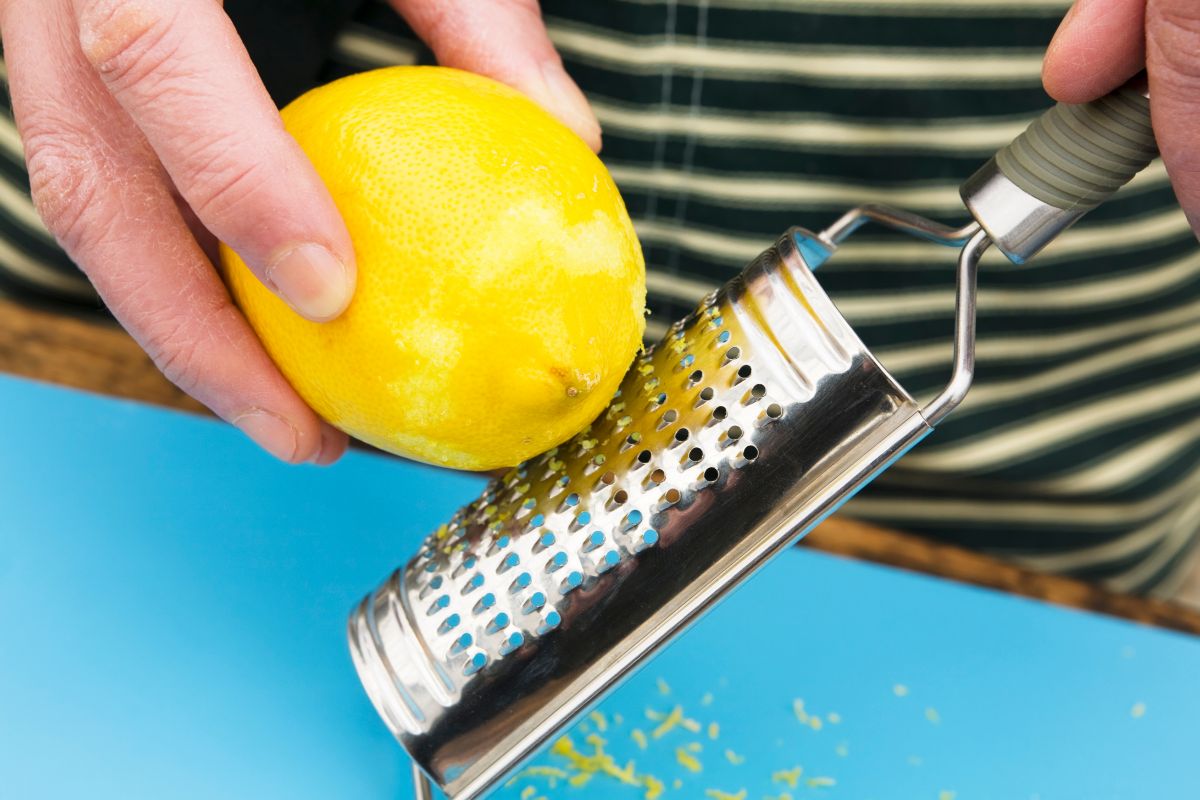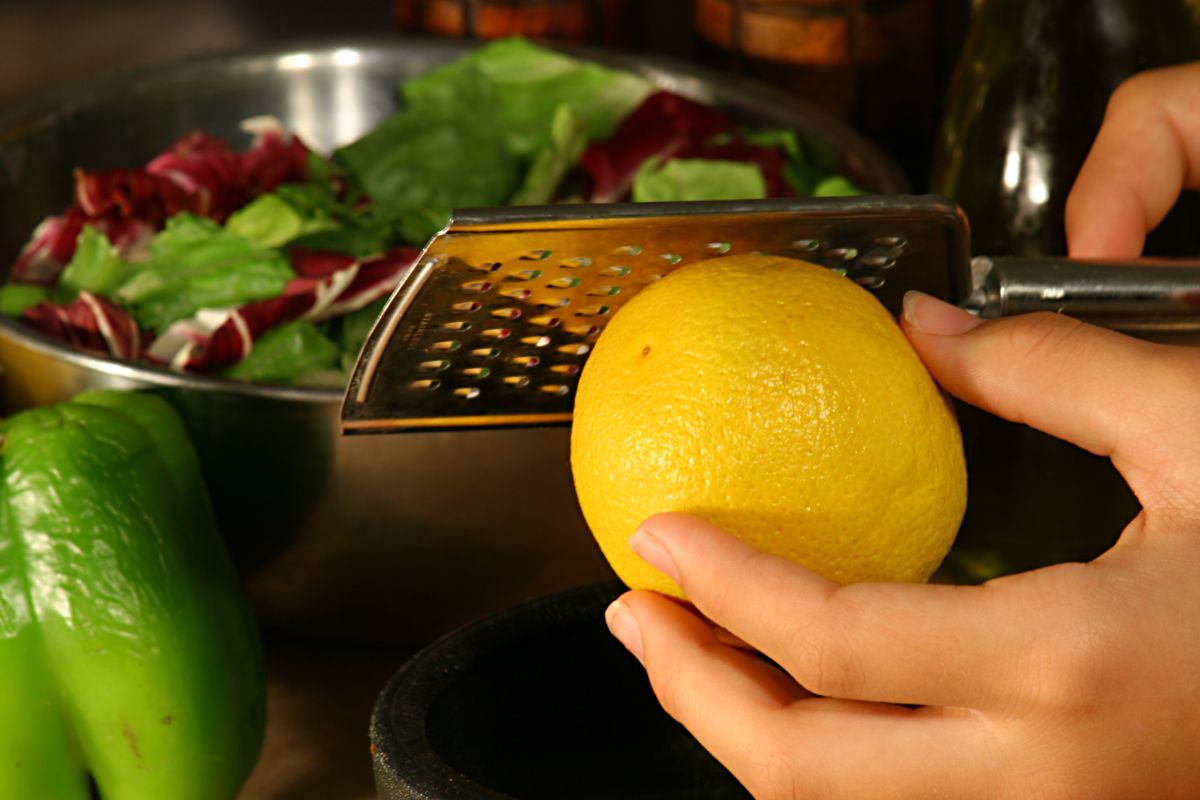Lemon is a wonderful flavor that’s used in both baking and cooking. Lemon can be used to make cakes, bars, and pies, as well as savory dishes, like sauces, dressings, and salads.
A lot of recipes use lemon juice to give their dishes a zesty touch, while others call for lemon zest.

If you’re wondering what lemon zest is as well as how to zest a lemon, you’re in the right place! You’ll find out how to zest a lemon with five effective methods outlined below.
We’ve also covered how much lemon zest is in a lemon, as well as how to remove a lemon’s wax coating before you begin zesting.
If you’re ready to start zesting your lemons, keep reading!
More About Lemon Zest
Lemon zest is an ingredient that is sourced from a lemon’s outer yellow peel. This is the porous, thin rind, not the juicy fruit within. Lemon zest contains several essential oils that give it a distinct taste and smell.
Note that lemon zest is not the white area underneath the peel. This coating is known as the pith. This is bitter and will give your dishes a bad texture and taste.
In most cases, you can get around a tablespoon of zest per lemon. This may vary depending on how big your fruit is. If you have larger or smaller lemons, you may obtain more or less lemon zest.
Unwaxed Or Waxed Lemons?
A lot of non-organic lemons have a waxy coating around the fruit. This gives the fruit a shiny, attractive coating and helps preserve the lemons so they last longer.
In most cases, the wax coating is safe to consume, but you may want to remove this before you start zesting.
If you want to de-wax your lemons, follow these steps:
- Pour water into a large pot and bring it to a boil on the stove.
- Transfer your lemons to a colander over your kitchen sink, then pour the hot water over the lemons.
- Start scrubbing the lemons with a vegetable brush to take off the wax coating.
- Use a clean paper towel to pat the lemons dry. Make sure they are completely dry before you start zesting them.
Another option is to purchase organic lemons. These will be free from wax, so you won’t need to de-wax them beforehand.
Zesting A Lemon: Microplane Zester
Now that you know some more about lemon zest, we can get into removing the zest from the fruit. You can do this in several ways, some of which are more effective than others.
Remember that you can use these methods to zest other fruit, like limes, grapefruit, and oranges!
Our first method involves using a Microplane zester. This is the most effective and easiest method of zesting a lemon. The term ‘Microplane’ is a company name, but it has been used to describe general rasp graters.
These graters have a fine-toothed surface that’s great for delicate grating. This is ideal for removing a thin zest coating off of citrus fruit, as well as finely grating types of cheese, like Parmesan.
A Microplane grater is used like a regular grater. Wash and dry your lemon beforehand and use light pressure when you use the grater. Swivel the fruit around as you go, so you grate all around the lemon.
It’s best to keep the lemon on a firm, steady surface, like a cutting board or a countertop. Use the grater upside down, as you’ll be able to notice when you get to the fruit’s white pith.
Another option is to hold the grater against a steady surface and grip the lemon with your dominant hand. Slide the fruit over the zester, taking care to obtain the yellow zest instead of the white pith.

Zesting A Lemon: Box Grater
If you can’t find or don’t have a rasp grater, you can use a hand-held grater or the fine end of a box grater to get similar results.
Use the sharp teeth or the fine holds to lightly shave the zest off of the fruit. Rotate the lemon as you carry on, as this helps prevent any tough white pith.
Zesting A Lemon: Channel Knife
This method is best for obtaining bigger slices or curls of zest. Bigger lemon zest strips work well as a garnish, giving cocktails, mocktails, and food dishes an attractive finish.
A channel knife has two main components. The little circles on the top will act as the zester, while the indented grater on the edge is the channel knife.
The zester area will create lengthy zest strings, but the channel knife will create a single, big, curly peel.
You may need to practice a few times with this tool, so keep this in mind before any large events.
To use the zester edge, grip the tool with your dominant hand and lightly press the zester into the lemon zest. Begin scraping the tool towards you, taking care not to remove the white pith.
If you want to use the channel knife, grip the tool with your dominant hand. Gently push the tool inwards and scrap, creating long zest strips as you go.
Zesting A Lemon: Knife
If you don’t have a zester or grater on hand, you can use a knife to remove a lemon’s zest. This is a tricky method that needs decent knife skills. You can use a small, sharp paring knife or a serrated knife.
With care, use your knife to slice the zest off of the lemon. Work in large areas and avoid cutting into the white pith.
Once you’re done, you can use the big pieces, or slice the zest strips into smaller shreds as required.
Zesting A Lemon: Vegetable Peeler
This is the trickiest zesting method which isn’t that effective.
If you have a firm fruit and a sharp vegetable peeler, you can use the tool like a paring knife, like the previous method. Use the peeler to take off long zest strips, taking care to avoid cutting yourself.
Most peelers aren’t that strong, so it’s easier to cut into the white pith beneath the peel. There’s a greater injury risk with this technique, so it’s best to use the other methods outlined above.
Final Thoughts
Now you know how to zest a lemon!
The five methods outlined above range in effectiveness, but if you plan on making lemon zest recipes regularly, we’d recommend purchasing a Microplane grater.
This is the easiest and most effective way of zesting a lemon, but if you don’t have one, a box grater will help you achieve similar results.
It’s harder to zest a lemon with a knife or vegetable peeler, so only use these two methods as a last resort.
We hope you enjoy making your lemon zest recipes!
- How To Reheat A Cheesesteak - November 5, 2023
- What Are Three Must Have Kitchen Knives? - September 22, 2023
- How To Protect Edges Of Pie Crust - June 15, 2023








